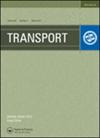针对转运中断风险的腹地-港口货运网络可靠规划
IF 1.3
4区 工程技术
Q3 TRANSPORTATION SCIENCE & TECHNOLOGY
引用次数: 0
摘要
以前的许多案例表明,港口运营容易受到破坏性事件的影响。本文提出了一种考虑成本风险规避的港口用户腹地-港口联运网络可靠规划的两阶段随机规划方法。多式联运终端的概率中断被认为是特定于场景的。在第一阶段,选择多式联运路径以获得适当的网络容量。在第二阶段,为计划网络上的每个中断场景分配货流。首先在风险中性环境下建立两阶段模型,以实现总成本的最小期望。然后,通过将条件风险值(Conditional Value-at-Risk, CVaR)风险度量工具纳入期望模型,采用平均风险(Mean-Risk, MR)框架,以降低最坏情况下中断情景的成本。引入Benders分解(Benders ' Decomposition, BD),有效地解决了指数多问题。在不同的风险规避参数下进行了数值实验。通过本文的研究,网络规划者可以确定合理冗余的网络容量,以经济有效的方式提高货运可靠性。所提出的方法为规划人员提供了一种简单的方法来量化成本中的风险偏好,并将其强加于规划过程中,从而权衡预期成本(EC)和最坏情况成本。本文章由计算机程序翻译,如有差异,请以英文原文为准。
RELIABLE PLANNING OF HINTERLAND-PORT FREIGHT NETWORK AGAINST TRANSFER DISRUPTION RISKS
Many previous cases have shown that port operations are susceptible to disruptive events. This paper proposes 2-stage Stochastic Programming (SP) for port users to reliably plan the hinterland-port intermodal freight network with consideration of risk aversion in cost. Probabilistic disruptions of intermodal terminals are considered as scenario-specific. In the 1st stage, intermodal paths are selected to obtain proper network capacities. In the 2nd stage, cargo flows are assigned for each disruption scenario on the planed network. The 2-stage model is firstly formulated in a risk-neutral environment to achieve the minimum expectation of total cost. Then, the Mean-Risk (MR) framework is adopted by incorporating a risk measure tool called Conditional Value-at-Risk (CVaR) into the expectation model, so as to reduce the cost of worst-case disruption scenarios. Benders’ Decomposition (BD) is introduced to efficiently solve the exponential many problem. Some numerical experiments are performed under different risk aversion parameters. With this study, network planners can decide network capacities with reasonable redundancies to improve the freight reliability in a cost-effective way. The proposed method provides a simple approach for the planners to quantify their risk appetites in cost and to impose them in the planning process, hence to trade-off the Expected Cost (EC) and the worst-case cost.
求助全文
通过发布文献求助,成功后即可免费获取论文全文。
去求助
来源期刊

Transport
Engineering-Mechanical Engineering
CiteScore
3.40
自引率
5.90%
发文量
19
审稿时长
4 months
期刊介绍:
At present, transport is one of the key branches playing a crucial role in the development of economy. Reliable and properly organized transport services are required for a professional performance of industry, construction and agriculture. The public mood and efficiency of work also largely depend on the valuable functions of a carefully chosen transport system. A steady increase in transportation is accompanied by growing demands for a higher quality of transport services and optimum efficiency of transport performance. Currently, joint efforts taken by the transport experts and governing institutions of the country are required to develop and enhance the performance of the national transport system conducting theoretical and empirical research.
TRANSPORT is an international peer-reviewed journal covering main aspects of transport and providing a source of information for the engineer and the applied scientist.
The journal TRANSPORT publishes articles in the fields of:
transport policy;
fundamentals of the transport system;
technology for carrying passengers and freight using road, railway, inland waterways, sea and air transport;
technology for multimodal transportation and logistics;
loading technology;
roads, railways;
airports, ports, transport terminals;
traffic safety and environment protection;
design, manufacture and exploitation of motor vehicles;
pipeline transport;
transport energetics;
fuels, lubricants and maintenance materials;
teamwork of customs and transport;
transport information technologies;
transport economics and management;
transport standards;
transport educology and history, etc.
 求助内容:
求助内容: 应助结果提醒方式:
应助结果提醒方式:


